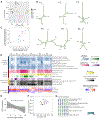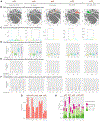Non-Genetic Intra-Tumor Heterogeneity Is a Major Predictor of Phenotypic Heterogeneity and Ongoing Evolutionary Dynamics in Lung Tumors
- PMID: 31747591
- PMCID: PMC6952742
- DOI: 10.1016/j.celrep.2019.10.045
Non-Genetic Intra-Tumor Heterogeneity Is a Major Predictor of Phenotypic Heterogeneity and Ongoing Evolutionary Dynamics in Lung Tumors
Abstract
Impacts of genetic and non-genetic intra-tumor heterogeneity (ITH) on tumor phenotypes and evolvability remain debated. We analyze ITH in lung squamous cell carcinoma at the levels of genome, transcriptome, and tumor-immune interactions and histopathological characteristics by multi-region bulk and single-cell sequencing. Genomic heterogeneity alone is a weak indicator of intra-tumor non-genetic heterogeneity at immune and transcriptomic levels that impact multiple cancer-related pathways, including those related to proliferation and inflammation, which in turn contribute to intra-tumor regional differences in histopathology and subtype classification. Tumor subclones have substantial differences in proliferation score, suggestive of non-neutral clonal dynamics. Proliferation and other cancer-related pathways also show intra-tumor regional differences, sometimes even within the same subclones. Neo-epitope burden negatively correlates with immune infiltration, indicating immune-mediated purifying selection on somatic mutations. Taken together, our observations suggest that non-genetic heterogeneity is a major determinant of heterogeneity in histopathological characteristics and impacts evolutionary dynamics in lung cancer.
Copyright © 2019 The Authors. Published by Elsevier Inc. All rights reserved.
Conflict of interest statement
DECLARATION OF INTERESTS
The authors declare no competing interests.
Figures





References
-
- Alexandrov LB, Nik-Zainal S, Wedge DC, Aparicio SAJR, Behjati S, Biankin AV, Bignell GR, Bolli N, Borg A, Børresen-Dale A-L, et al.; Australian Pancreatic Cancer Genome Initiative; ICGC Breast Cancer Consortium; ICGC MMML-Seq Consortium; ICGC PedBrain (2013). Signatures of mutational processes in human cancer. Nature 500, 415–421. - PMC - PubMed
-
- Ardeshir-Larijani F, Bhateja P, Lipka MB, Sharma N, Fu P, and Dowlati A (2018). KMT2D Mutation Is Associated With Poor Prognosis in Non-Small-Cell Lung Cancer. Clin. Lung Cancer 19, e489–e501. - PubMed
Publication types
MeSH terms
Grants and funding
LinkOut - more resources
Full Text Sources
Medical

